Modelling a Segmented Skutterudite-Based Thermoelectric Generator to Achieve Maximum Conversion Efficiency
Abstract
1. Introduction
2. Materials and Methods
2.1. Overview of Material Preparation
2.2. Thermoelectric Generator Module
2.3. Segmentation
2.4. Governing Equations for the Simulation
3. Results
3.1. Discussion
3.2. Contact Resistance
3.3. Radiation and Convection Losses
3.4. Diffusion Barrier
4. Conclusions
Author Contributions
Funding
Conflicts of Interest
References
- Series, S. Introduction to Thermoelectricity; Goldsmid, H.J., Ed.; Springer: Berlin/Heidelberg, Germany, 2009; ISBN 9783642007156. [Google Scholar]
- Heremans, J.P.; Jovovic, V.; Toberer, E.S.; Saramat, A.; Kurosaki, K.; Charoenphakdee, A.; Yamanaka, S.; Snyder, G.J. Enhancement of thermoelectric efficiency in PbTe by distortion of the electronic density of states. Science 2008, 321, 554–557. [Google Scholar] [CrossRef] [PubMed]
- Ballikaya, S.; Uzar, N.; Yildirim, S.; Salvador, J.R. Electrical and thermal properties of Fe substituted double-filled BaxYbyFezCo4−zSb12 skutterudites. J. Solid State Chem. 2013, 197, 440–446. [Google Scholar] [CrossRef]
- Ballikaya, S.; Uher, C. Enhanced thermoelectric performance of optimized Ba, Yb filled and Fe substituted skutterudite compounds. J. Alloys Compd. 2014, 585, 168–172. [Google Scholar] [CrossRef]
- Prado-Gonjal, J.; Vaqueiro, P.; Nuttall, C.; Potter, R.; Powell, A.V. Enhancing the thermoelectric properties of single and double filled p-type skutterudites synthesized by an up-scaled ball-milling process. J. Alloys Compd. 2017, 695, 3598–3604. [Google Scholar] [CrossRef]
- Rogl, G.; Grytsiv, A.; Rogl, P.; Peranio, N.; Bauer, E.; Zehetbauer, M.; Eibl, O. N-Type skutterudites (R,Ba,Yb)yCo4Sb12 (R = Sr, La, Mm, DD, SrMm, SrDD) approaching ZT ≈ 2.0. Acta Mater. 2014, 63, 30–43. [Google Scholar] [CrossRef]
- Deng, S.K.; Li, D.C.; Shen, L.X.; Hao, R.T.; Takabatake, T. Sn-based type-VIII single-crystal clathrates with a large figure of merit. Chin. Phys. B 2012, 21, 017401. [Google Scholar] [CrossRef]
- Roudebush, J.H.; Toberer, E.S.; Hope, H.; Jeffrey Snyder, G.; Kauzlarich, S.M. Crystal structure, characterization and thermoelectric properties of the type-I clathrate Ba8−ySryAl14Si32 (0.6 ≤ y ≤ 1.3) prepared by aluminum flux. J. Solid State Chem. 2011, 184, 1176–1185. [Google Scholar] [CrossRef]
- Shi, X.; Yang, J.; Bai, S.; Yang, J.; Wang, H.; Chi, M.; Salvador, J.R.; Zhang, W.; Chen, L.; Wong-Ng, W. On the design of high-efficiency thermoelectric clathrates through a systematic cross-substitution of framework elements. Adv. Funct. Mater. 2010, 20, 755–763. [Google Scholar] [CrossRef]
- Poon, S.J. Recent advances in thermoelectric performance of half-heusler compounds. Metals 2018, 8, 989. [Google Scholar] [CrossRef]
- Yu, C.; Zhu, T.J.; Shi, R.Z.; Zhang, Y.; Zhao, X.B.; He, J. High-performance half-Heusler thermoelectric materials Hf1−x ZrxNiSn1−ySby prepared by levitation melting and spark plasma sintering. Acta Mater. 2009, 57, 2757–2764. [Google Scholar] [CrossRef]
- Maji, P.; Makongo, J.P.A.; Zhou, X.; Chi, H.; Uher, C.; Poudeu, P.F.P. Thermoelectric performance of nanostructured p-type Zr0.5Hf 0.5Co0.4Rh0.6Sb1−xSnx half-Heusler alloys. J. Solid State Chem. 2013, 202, 70–76. [Google Scholar] [CrossRef]
- Feng, Y.; Jiang, X.; Ghafari, E.; Kucukgok, B.; Zhang, C.; Ferguson, I.; Lu, N. Metal oxides for thermoelectric power generation and beyond. Adv. Compos. Hybrid Mater. 2018, 1, 114–126. [Google Scholar] [CrossRef]
- Li, S.; Funahashi, R.; Matsubara, I.; Yamada, H.; Ueno, K.; Sodeoka, S. Synthesis and thermoelectric properties of the new oxide ceramics Ca3−xSrxCo4O9 + δ (x = 0.0–1.0). Ceram. Int. 2001, 27, 321–324. [Google Scholar] [CrossRef]
- Wu, T.; Gao, P. Development of perovskite-type materials for thermoelectric application. Materials 2018, 11, 999. [Google Scholar] [CrossRef] [PubMed]
- Bocher, L.; Aguirre, M.H.; Robert, R.; Logvinovich, D.; Bakardjieva, S.; Hejtmanek, J.; Weidenkaff, A. High-temperature stability, structure and thermoelectric properties of CaMn1−xNbxO3 phases. Acta Mater. 2009, 57, 5667–5680. [Google Scholar] [CrossRef]
- Ballikaya, S.; Oner, Y.; Temel, T.; Ozkal, B.; Bailey, T.P.; Toprak, M.S.; Uher, C. Thermoelectric and thermal stability improvements in Nano-Cu2 Se included Ag2 Se. J. Solid State Chem. 2019, 273, 122–127. [Google Scholar] [CrossRef]
- Biswas, K.; He, J.; Blum, I.D.; Wu, C.I.; Hogan, T.P.; Seidman, D.N.; Dravid, V.P.; Kanatzidis, M.G. High-performance bulk thermoelectrics with all-scale hierarchical architectures. Nature 2012, 489, 414–418. [Google Scholar] [CrossRef]
- Beekman, M.; Morelli, D.; Nolas, G. Better thermoelectrics through glass-like crystals. Nat. Mater. 2015, 14, 1182–1185. [Google Scholar] [CrossRef]
- Liu, H.; Shi, X.; Xu, F.; Zhang, L.; Zhang, W.; Chen, L.; Li, Q.; Uher, C.; Day, T.; Snyder Jeffrey, G. Copper ion liquid-like thermoelectrics. Nat. Mater. 2012, 11, 422–425. [Google Scholar] [CrossRef]
- Rogl, G.; Rogl, P. Skutterudites, a most promising group of thermoelectric materials. Curr. Opin. Green Sustain. Chem. 2017, 4, 50–57. [Google Scholar] [CrossRef]
- Uher, C. Skutterudites: Prospective Novel Thermoelectrics; Elsevier: Amsterdam, The Netherlands, 2001. [Google Scholar]
- Ballikaya, S.; Sertkol, M.; Oner, Y.; Bailey, T.P.; Uher, C. Fracture structure and thermoelectric enhancement of Cu2 Se with substitution of nanostructured Ag2Se. Phys. Chem. Chem. Phys. 2019, 21, 13569–13577. [Google Scholar] [CrossRef] [PubMed]
- Yang, J.; Chen, Y.; Peng, J.; Song, X.; Zhu, W.; Su, J.; Chen, R. Synthesis of CoSb3 skutterudite by mechanical alloying. J. Alloys Compd. 2004, 375, 229–232. [Google Scholar] [CrossRef]
- Yang, L.; Chen, Z.G.; Hong, M.; Han, G.; Zou, J. Enhanced Thermoelectric Performance of Nanostructured Bi2Te3 through Significant Phonon Scattering. ACS Appl. Mater. Interfaces 2015, 7, 23694–23699. [Google Scholar] [CrossRef] [PubMed]
- Forster, J.D.; Lynch, J.J.; Coates, N.E.; Liu, J.; Jang, H.; Zaia, E.; Gordon, M.P.; Szybowski, M.; Sahu, A.; Cahill, D.G.; et al. Solution-Processed Cu2Se nanocrystal films with bulk-like thermoelectric performance. Sci. Rep. 2017, 7, 2765. [Google Scholar] [CrossRef] [PubMed]
- Ibáñez, M.; Luo, Z.; Genç, A.; Piveteau, L.; Ortega, S.; Cadavid, D.; Dobrozhan, O.; Liu, Y.; Nachtegaal, M.; Zebarjadi, M.; et al. High-performance thermoelectric nanocomposites from nanocrystal building blocks. Nat. Commun. 2016, 7, 10766. [Google Scholar] [CrossRef] [PubMed]
- Ortega, S.; Ibáñez, M.; Liu, Y.; Zhang, Y.; Kovalenko, M.V.; Cadavid, D.; Cabot, A. Bottom-up engineering of thermoelectric nanomaterials and devices from solution-processed nanoparticle building blocks. Chem. Soc. Rev. 2017, 46, 3510–3528. [Google Scholar] [CrossRef] [PubMed]
- Ballikaya, S.; Chi, H.; Salvador, J.R.; Uher, C. Thermoelectric properties of Ag-doped Cu2Se and Cu2Te. J. Mater. Chem. A 2013, 1, 12478–12484. [Google Scholar] [CrossRef]
- Dong, H.; Li, X.; Huang, X.; Zhou, Y.; Jiang, W.; Chen, L. Improved oxidation resistance of thermoelectric skutterudites coated with composite glass. Ceram. Int. 2013, 39, 4551–4557. [Google Scholar] [CrossRef]
- Tang, X.F.; Chen, L.D.; Goto, T.; Hirai, T.; Yuan, R.Z. Synthesis and thermoelectric properties of filled skutterudite compounds CeyFexCo4−xSb12 by solid state reaction. J. Mater. Sci. 2001, 36, 5435–5439. [Google Scholar] [CrossRef]
- Ballikaya, S.; Uzar, N.; Yildirim, S.; Chi, H.; Su, X.; Tan, G.; Tang, X.; Uher, C. Lower thermal conductivity and higher thermoelectric performance of Fe-substituted and Ce, Yb double-filled p-type skutterudites. J. Electron. Mater. 2013, 42, 1622–1627. [Google Scholar] [CrossRef]
- Saleemi, M.; Toprak, M.S.; Li, S.; Johnsson, M.; Muhammed, M. Synthesis, processing, and thermoelectric properties of bulk nanostructured bismuth telluride (Bi2Te3). J. Mater. Chem. 2012, 22, 725–730. [Google Scholar] [CrossRef]
- Zybała, R.; Mars, K.; Mikuła, A.; Bogusławski, J.; Soboń, G.; Sotor, J.; Schmidt, M.; Kaszyca, K.; Chmielewski, M.; Ciupiński, L.; et al. Synthesis and Characterization of Antimony Telluride for Thermoelectric and Optoelectronic Applications. Arch. Metall. Mater. 2017, 62, 1067–1070. [Google Scholar] [CrossRef]
- Tafti, M.Y.; Ballikaya, S.; Khachatourian, A.M.; Noroozi, M.; Saleemi, M.; Han, L.; Nong, N.V.; Bailey, T.; Uher, C.; Toprak, M.S. Promising bulk nanostructured Cu2Se thermoelectrics: Via high throughput and rapid chemical synthesis. RSC Adv. 2016, 6, 111457–111464. [Google Scholar] [CrossRef]
- Kim, H.; Ballikaya, S.; Chi, H.; Ahn, J.P.; Ahn, K.; Uher, C.; Kaviany, M. Ultralow thermal conductivity of β-Cu2Se by atomic fluidity and structure distortion. Acta Mater. 2015, 86, 247–253. [Google Scholar] [CrossRef]
- Bendt, G.; Weber, A.; Heimann, S.; Assenmacher, W.; Prymak, O.; Schulz, S. Wet-chemical synthesis of different bismuth telluride nanoparticles using metal organic precursors-single source vs. dual source approach. Dalton Trans. 2015, 44, 14272–14280. [Google Scholar] [CrossRef]
- Sirusi, A.A.; Ballikaya, S.; Uher, C.; Ross, J.H. Low-Temperature Structure and Dynamics in Cu2Se. J. Phys. Chem. C 2015, 119, 20293–20298. [Google Scholar] [CrossRef]
- Salvador, J.R.; Waldo, R.A.; Wong, C.A.; Tessema, M.; Brown, D.N.; Miller, D.J.; Wang, H.; Wereszczak, A.A.; Cai, W. Thermoelectric and mechanical properties of melt spun and spark plasma sintered n-type Yb- and Ba-filled skutterudites. Mater. Sci. Eng. B 2013, 178, 1087–1096. [Google Scholar] [CrossRef]
- Martynova, K.V.; Rogacheva, E.I. Thermoelectric properties of cold pressed samples of semiconductor (Bi1-xSbx)2Te3 solid solutions. Funct. Mater. 2018, 25, 54–60. [Google Scholar] [CrossRef]
- Cui, J.L.; Xue, H.F.; Xiu, W.J. Microstructures and thermoelectric properties of p-type pseudo-binary AgxBi0.5Sb1.5−xTe3 (x = 0.05–0.4) alloys prepared by cold pressing. Mater. Lett. 2006, 60, 3669–3672. [Google Scholar] [CrossRef]
- Nguyen, V.Q.; Nguyen, T.H.; Duong, V.T.; Lee, J.E.; Park, S.D.; Song, J.Y.; Park, H.M.; Duong, A.T.; Cho, S. Thermoelectric Properties of Hot-Pressed Bi-Doped n-Type Polycrystalline SnSe. Nanoscale Res. Lett. 2018, 13, 4–10. [Google Scholar] [CrossRef]
- Brož, P.; Zelenka, F.; Kohoutek, Z.; Vřešťál, J.; Vykoukal, V.; Buršík, J.; Zemanová, A.; Rogl, G.; Rogl, P. Study of thermal stability of CoSb3 skutterudite by Knudsen effusion mass spectrometry. Calphad Comput. Coupling Phase Diagrams Thermochem. 2019, 65, 1–7. [Google Scholar] [CrossRef]
- Ouyang, Z.; Li, D. Modelling of segmented high-performance thermoelectric generators with effects of thermal radiation, electrical and thermal contact resistances. Sci. Rep. 2016, 6, 24123. [Google Scholar] [CrossRef] [PubMed]
- Snyder, G.J. Application of the compatibility factor to the design of segmented and cascaded thermoelectric generators. Appl. Phys. Lett. 2004, 84, 2436–2438. [Google Scholar] [CrossRef]
- User’s Guide, COMSOL Multiphysics® v. 4.3; COMSOL AB: Stockholm, Sweden, 2012.
- Sarhadi, A.; Bjørk, R.; Pryds, N. Optimization of the Mechanical and Electrical Performance of a Thermoelectric Module. J. Electron. Mater. 2015, 44, 4465–4472. [Google Scholar] [CrossRef]
- Bjørk, R. The Universal Influence of Contact Resistance on the Efficiency of a Thermoelectric Generator. J. Electron. Mater. 2015, 44, 2869–2876. [Google Scholar] [CrossRef]
- Bjørk, R.; Christensen, D.V.; Eriksen, D.; Pryds, N. Analysis of the internal heat losses in a thermoelectric generator. Int. J. Therm. Sci. 2014, 85, 12–20. [Google Scholar] [CrossRef]
- Wu, H.J.; Wu, A.T.; Wei, P.C.; Chen, S.W. Interfacial reactions in thermoelectric modules. Mater. Res. Lett. 2018, 6, 244–248. [Google Scholar] [CrossRef]
- Song, B.; Lee, S.; Cho, S.; Song, M.J.; Choi, S.M.; Seo, W.S.; Yoon, Y.; Lee, W. The effects of diffusion barrier layers on the microstructural and electrical properties in CoSb3 thermoelectric modules. J. Alloys Compd. 2014, 617, 160–162. [Google Scholar] [CrossRef]
- Shi, L.; Huang, X.; Gu, M.; Chen, L. Interfacial structure and stability in Ni/SKD/Ti/Ni skutterudite thermoelements. Surf. Coat. Technol. 2016, 285, 312–317. [Google Scholar] [CrossRef]
- Zybala, R.; Wojciechowski, K.; Schmidt, M.; Mania, R. Junctions and diffusion barriers for high temperature thermoelectric modules. In Proceedings of the 11th International Conference and Exhibition of the European Ceramic Society, Krakow, Poland, 21–25 June 2009; Volume 1, pp. 341–344. [Google Scholar]
- Park, S.H.; Jin, Y.; Ahn, K.; Chung, I.; Yoo, C.Y. Ag/Ni Metallization Bilayer: A Functional Layer for Highly Efficient Polycrystalline SnSe Thermoelectric Modules. J. Electron. Mater. 2017, 46, 848–855. [Google Scholar] [CrossRef]
- Kim, Y.; Yoon, G.; Cho, B.J.; Park, S.H. Multi-layer metallization structure development for highly efficient polycrystalline SnSe thermoelectric devices. Appl. Sci. 2017, 7, 1116. [Google Scholar] [CrossRef]
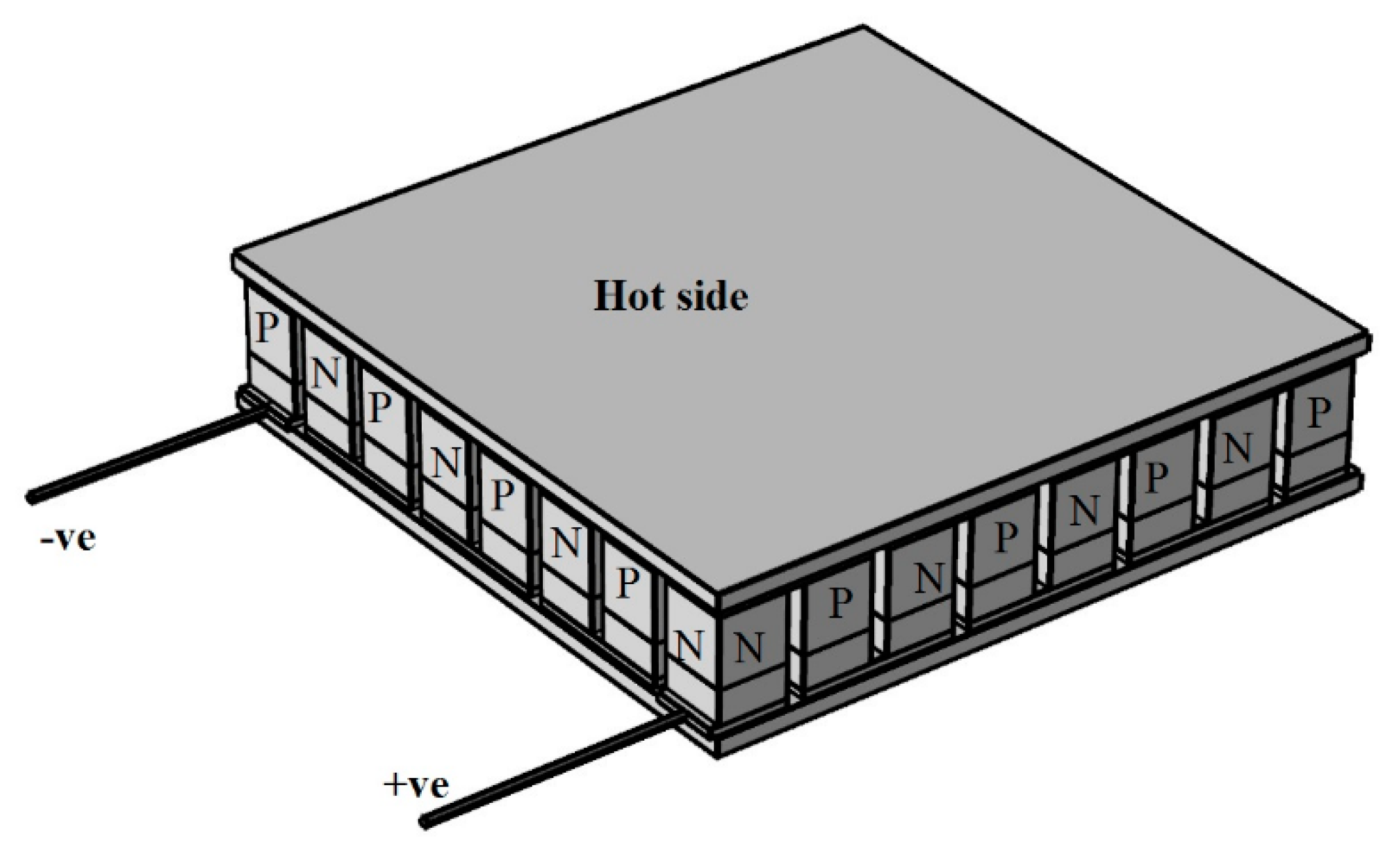

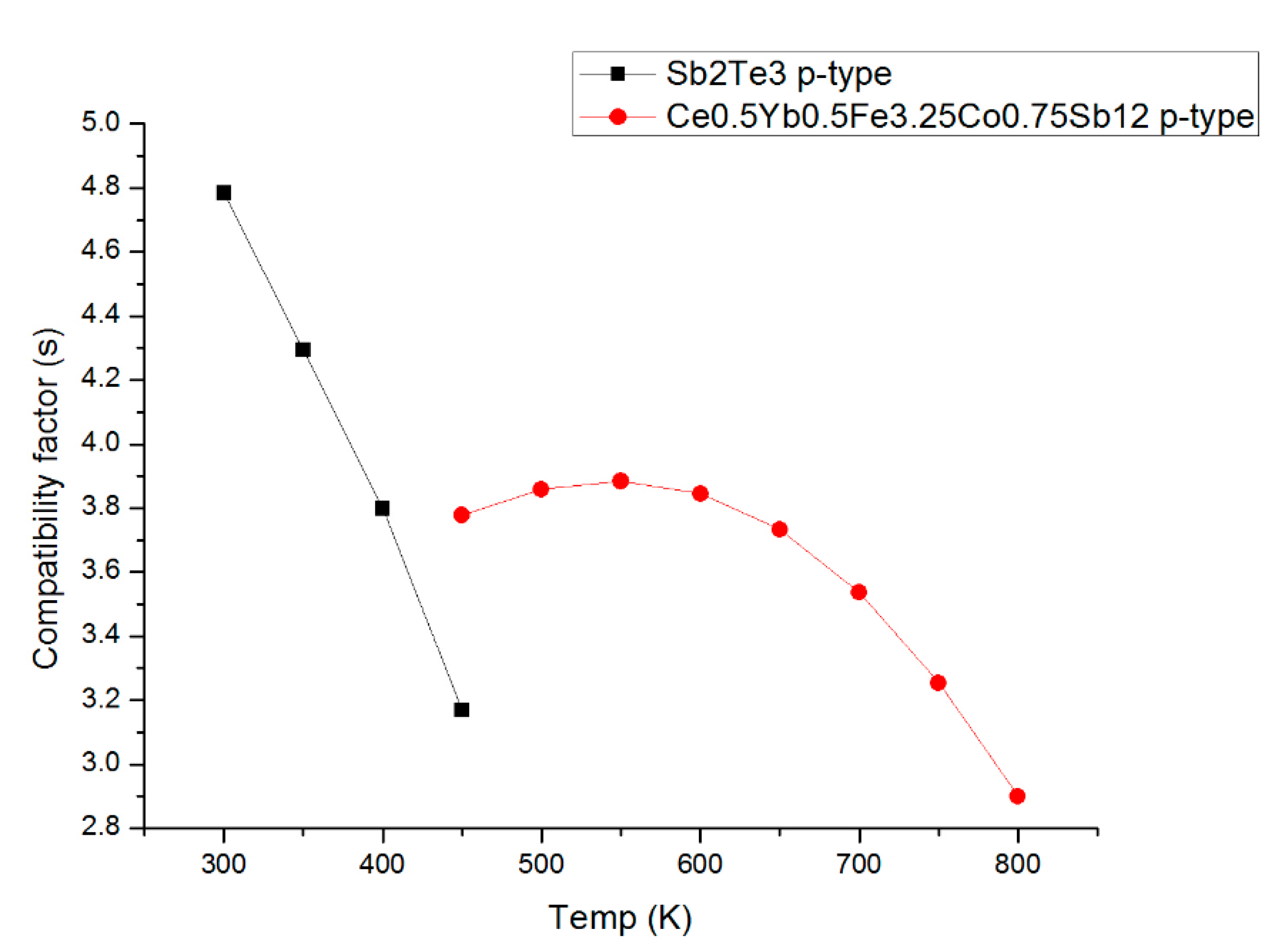
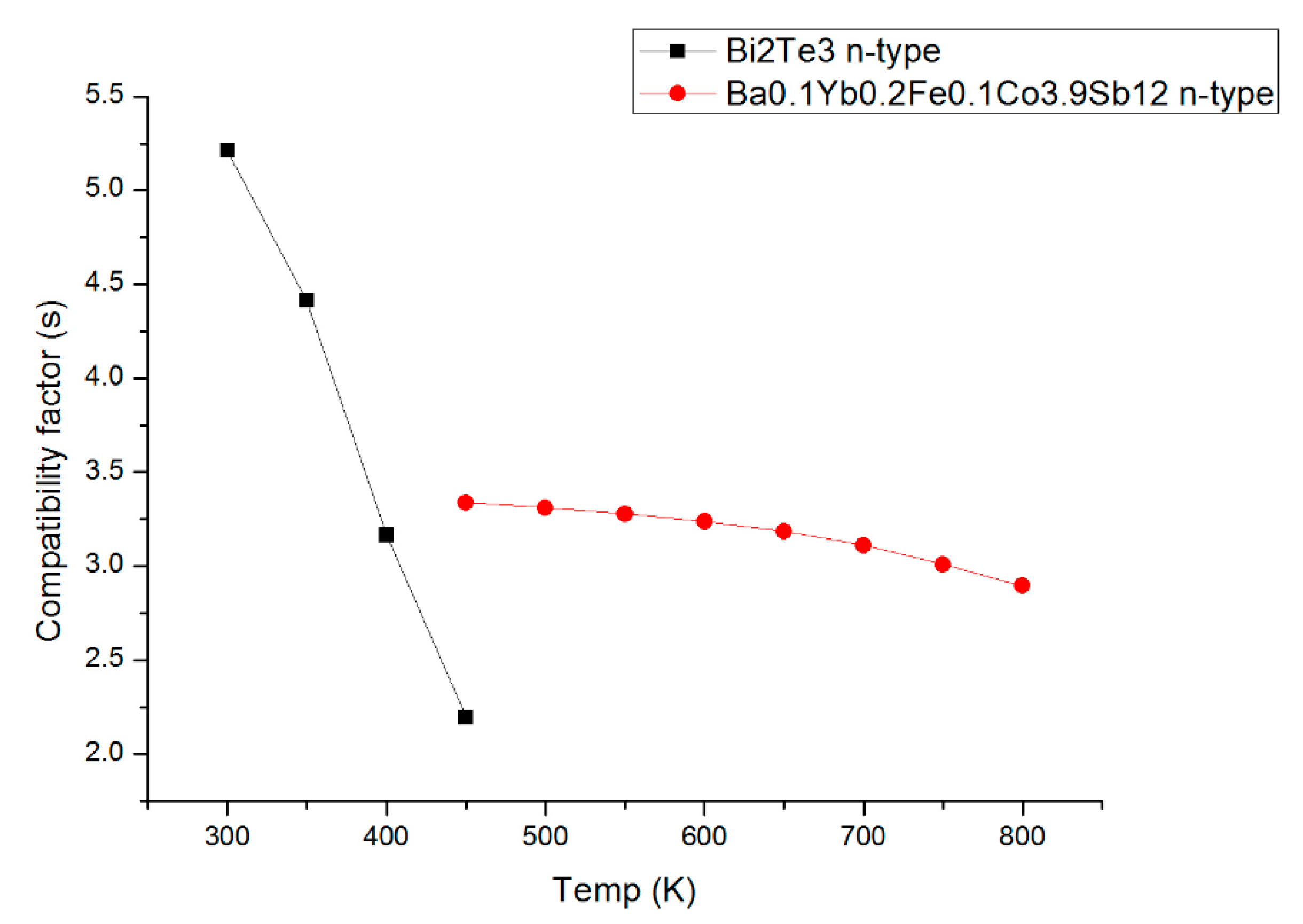
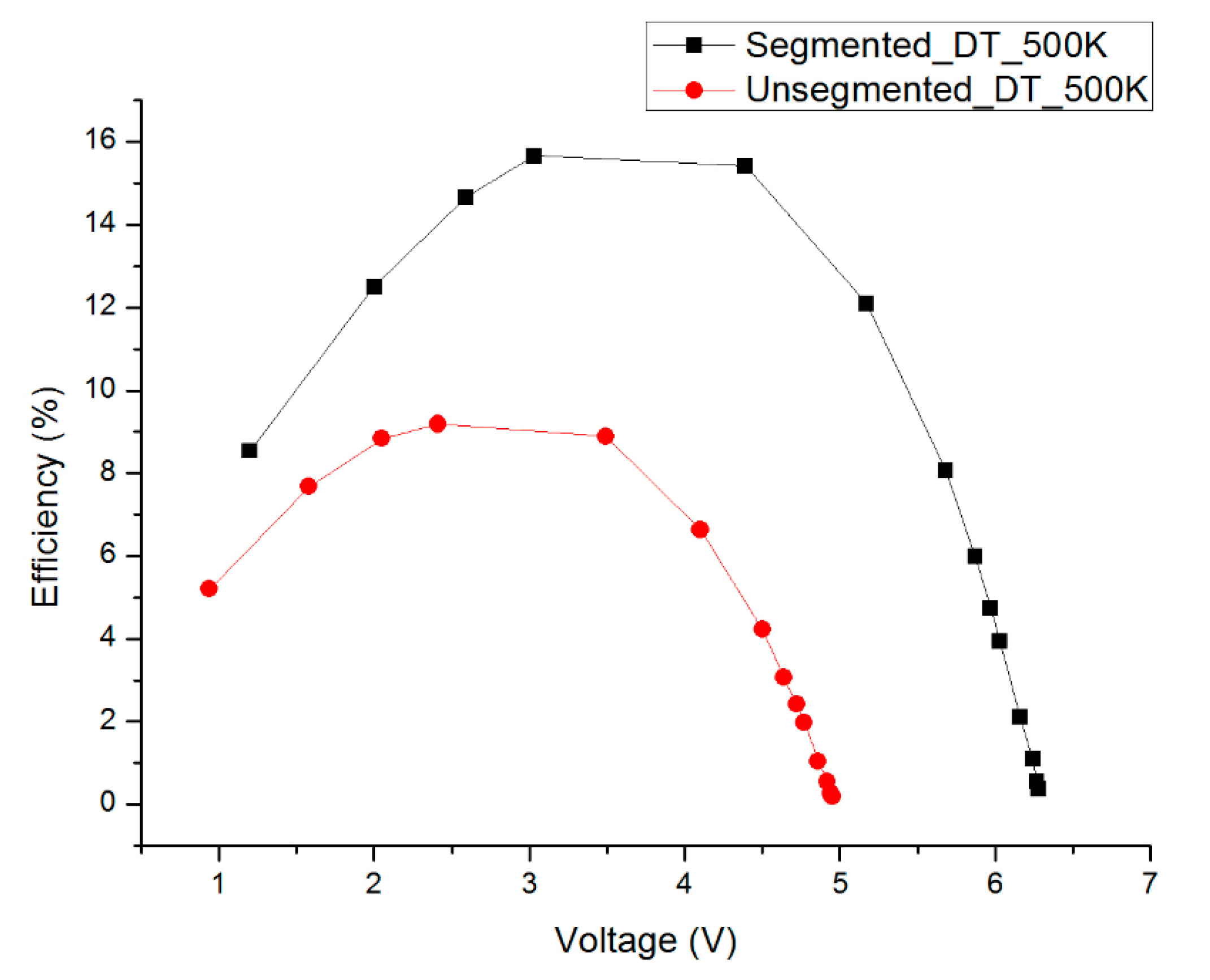
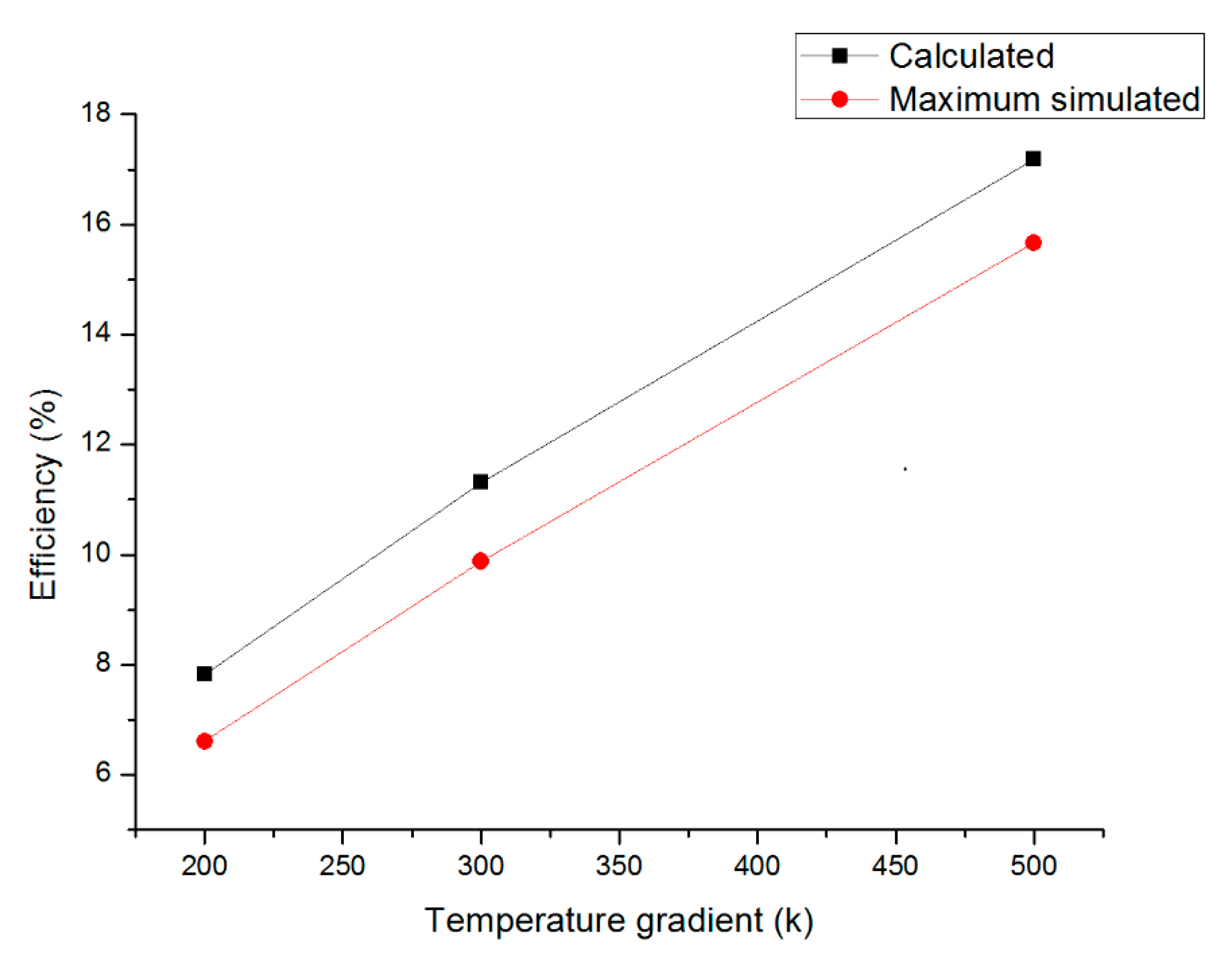

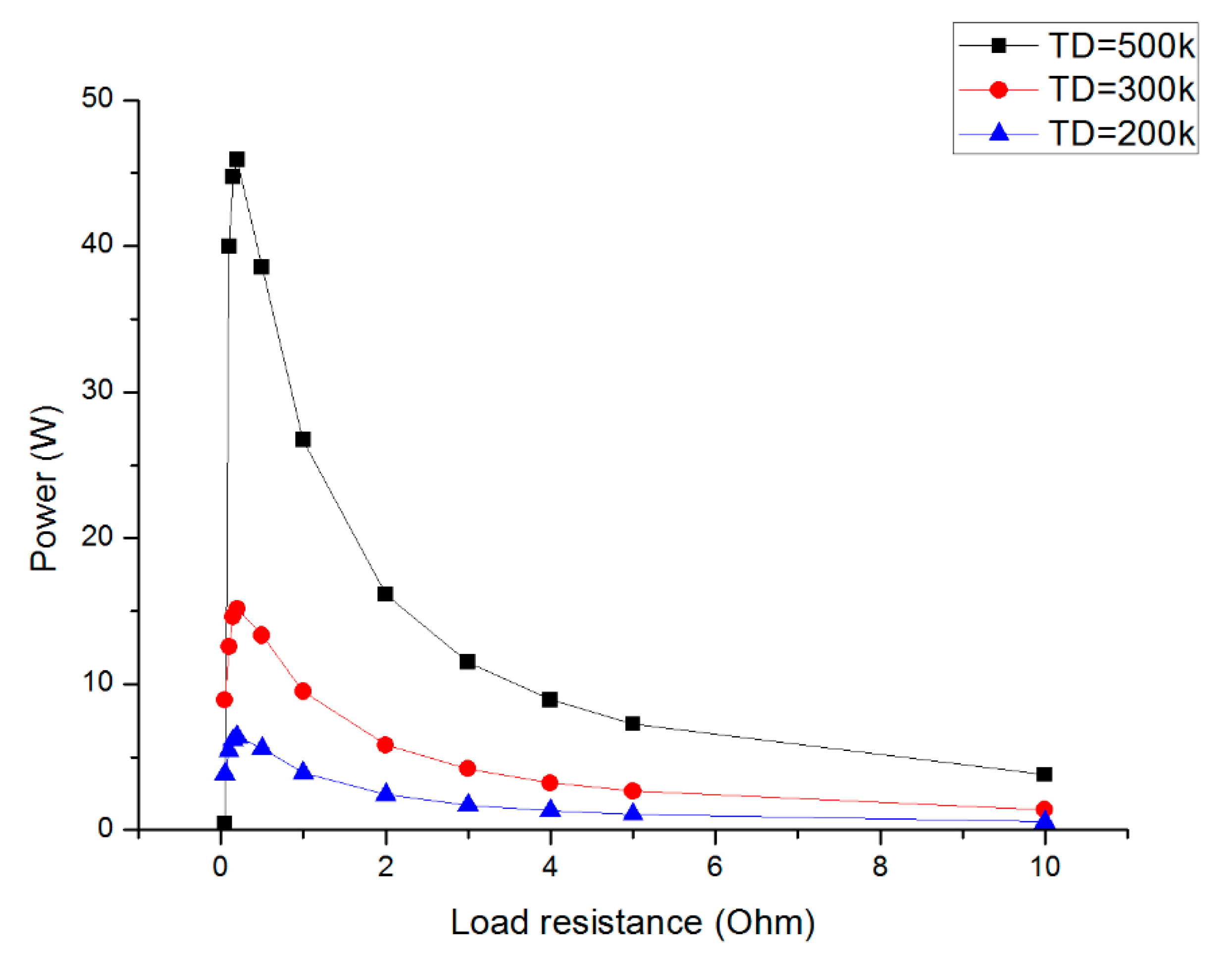
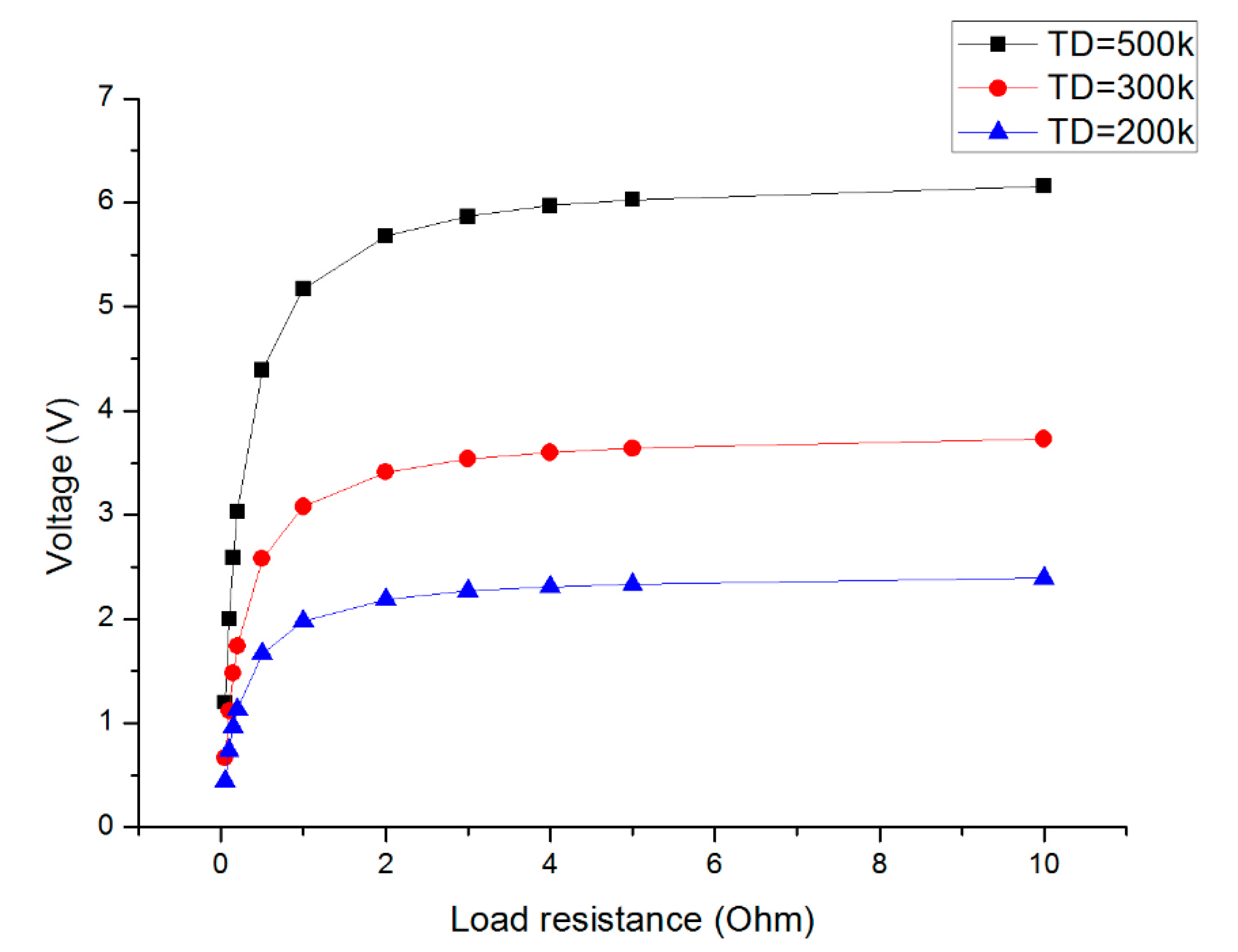
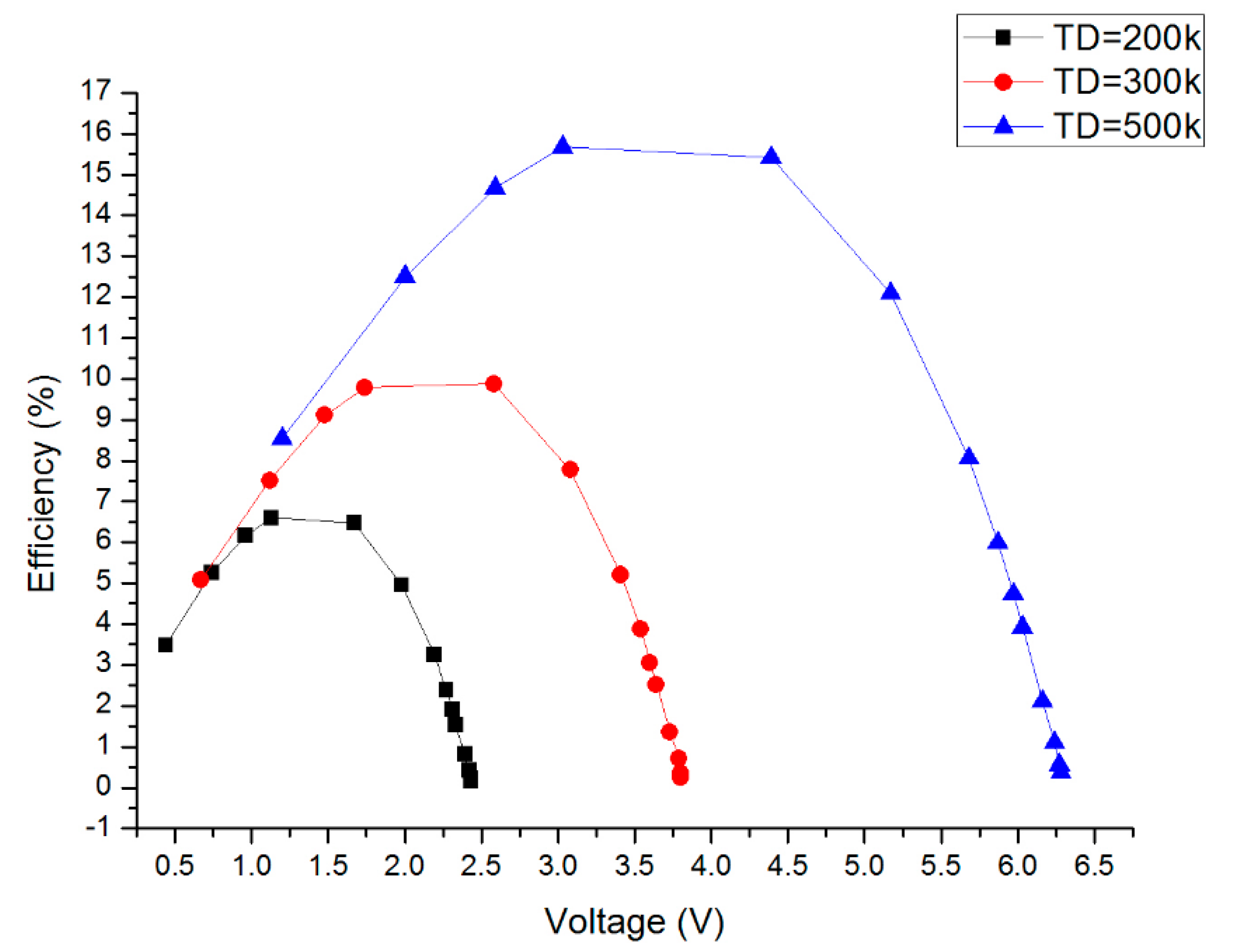
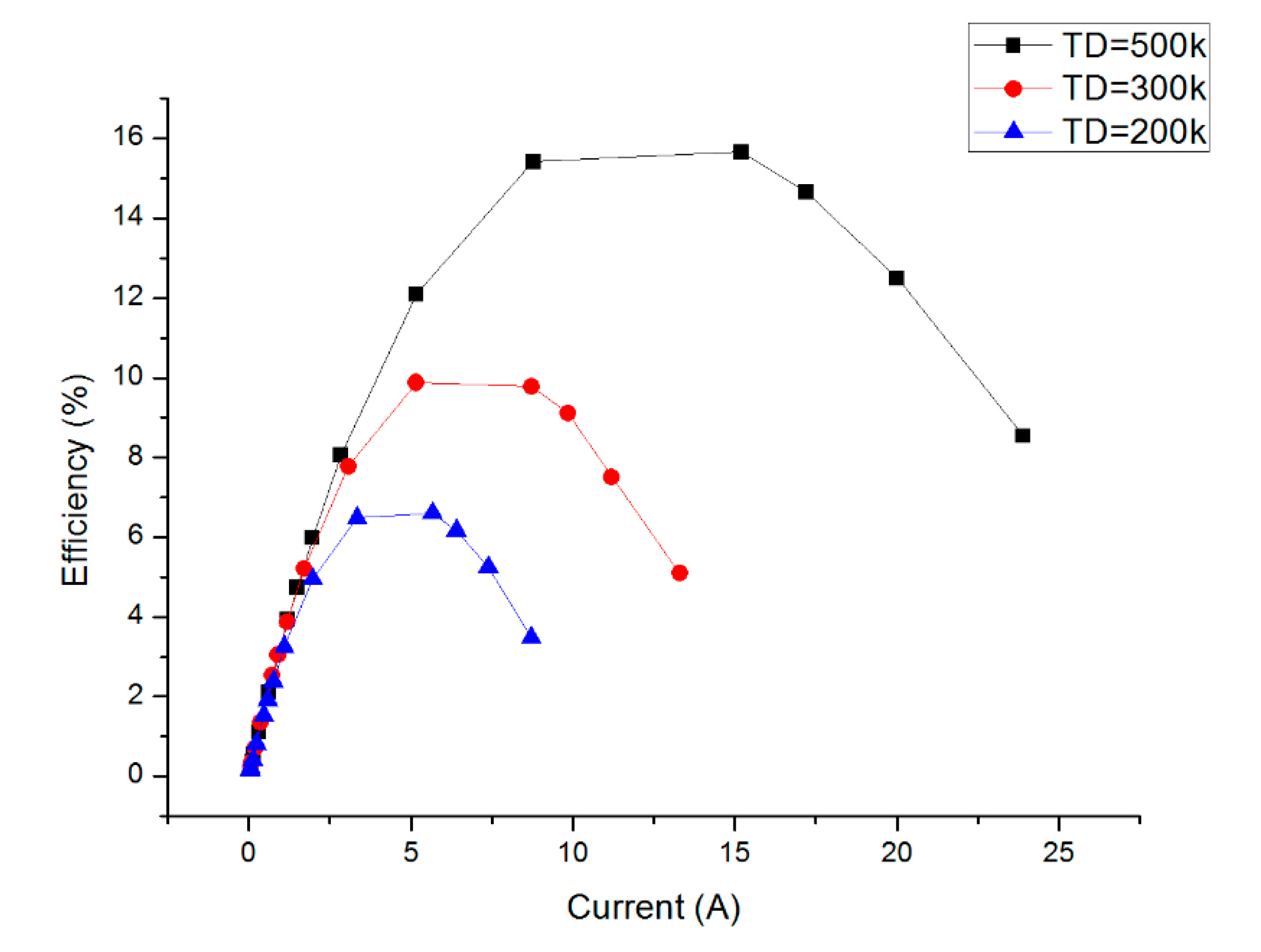
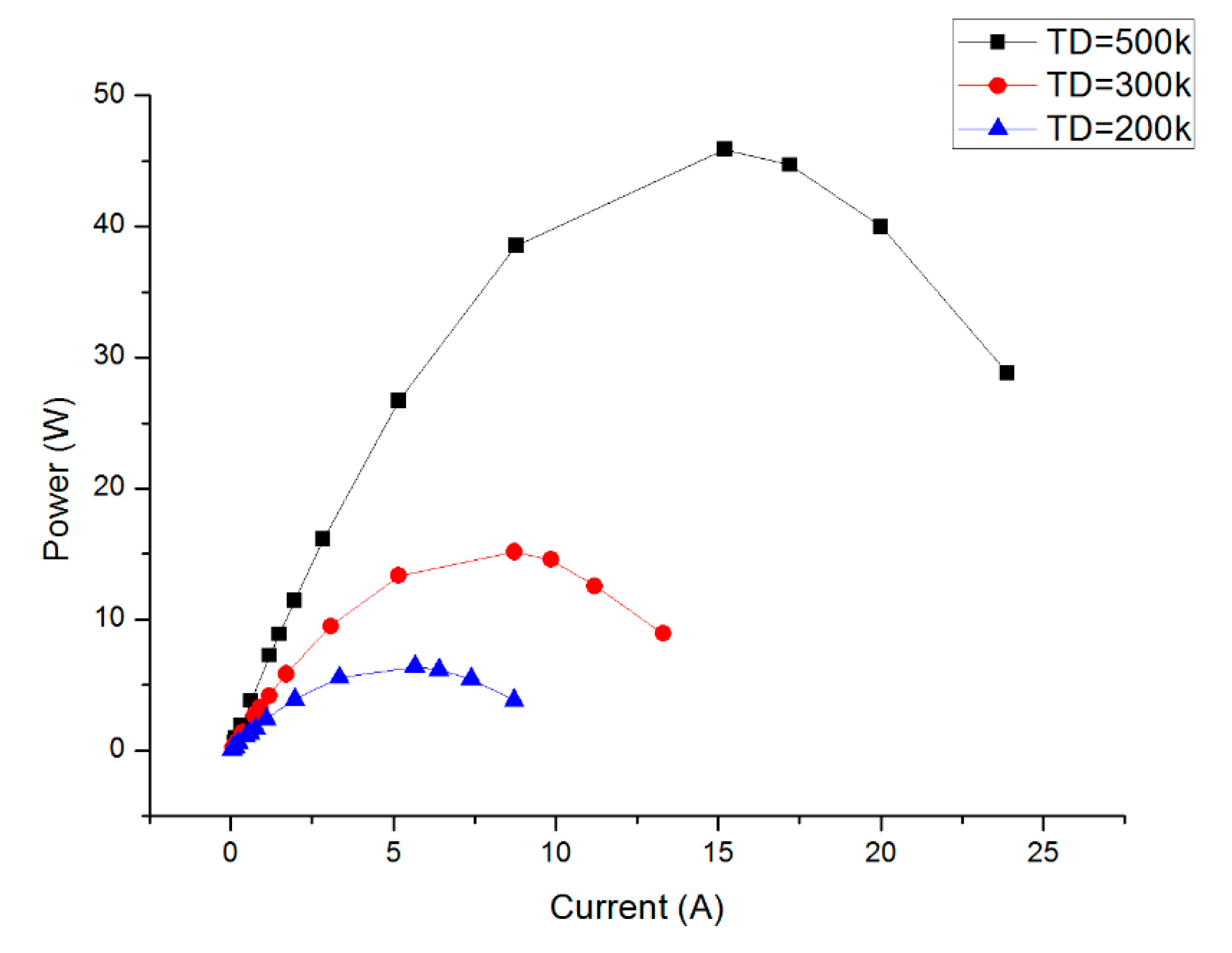
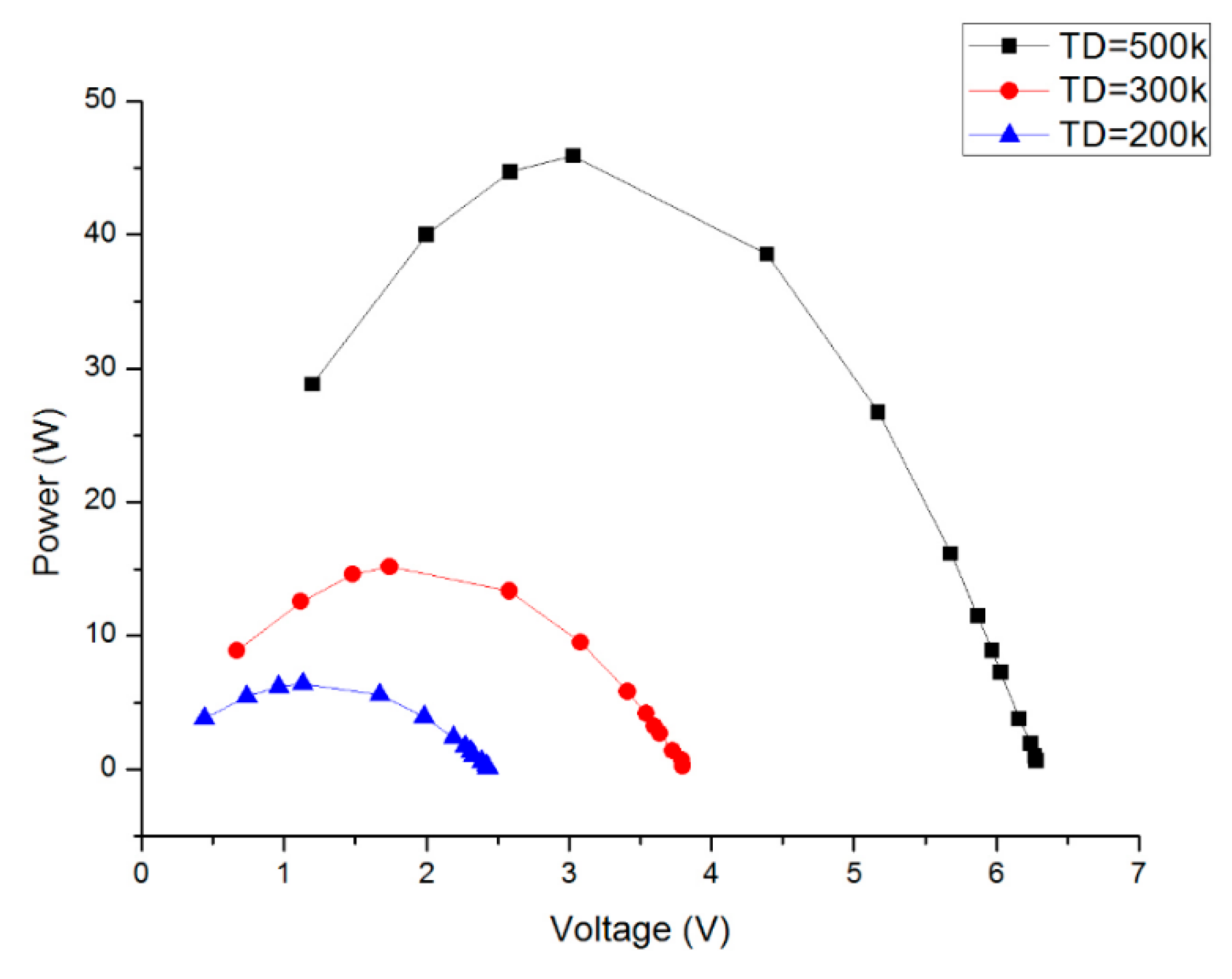
© 2020 by the authors. Licensee MDPI, Basel, Switzerland. This article is an open access article distributed under the terms and conditions of the Creative Commons Attribution (CC BY) license (http://creativecommons.org/licenses/by/4.0/).
Share and Cite
Yusuf, A.; Ballikaya, S. Modelling a Segmented Skutterudite-Based Thermoelectric Generator to Achieve Maximum Conversion Efficiency. Appl. Sci. 2020, 10, 408. https://doi.org/10.3390/app10010408
Yusuf A, Ballikaya S. Modelling a Segmented Skutterudite-Based Thermoelectric Generator to Achieve Maximum Conversion Efficiency. Applied Sciences. 2020; 10(1):408. https://doi.org/10.3390/app10010408
Chicago/Turabian StyleYusuf, Aminu, and Sedat Ballikaya. 2020. "Modelling a Segmented Skutterudite-Based Thermoelectric Generator to Achieve Maximum Conversion Efficiency" Applied Sciences 10, no. 1: 408. https://doi.org/10.3390/app10010408
APA StyleYusuf, A., & Ballikaya, S. (2020). Modelling a Segmented Skutterudite-Based Thermoelectric Generator to Achieve Maximum Conversion Efficiency. Applied Sciences, 10(1), 408. https://doi.org/10.3390/app10010408




